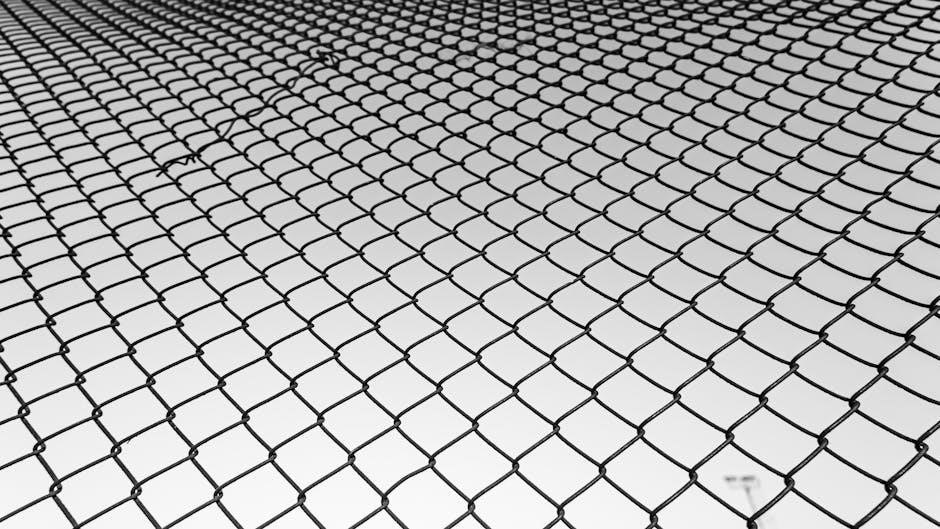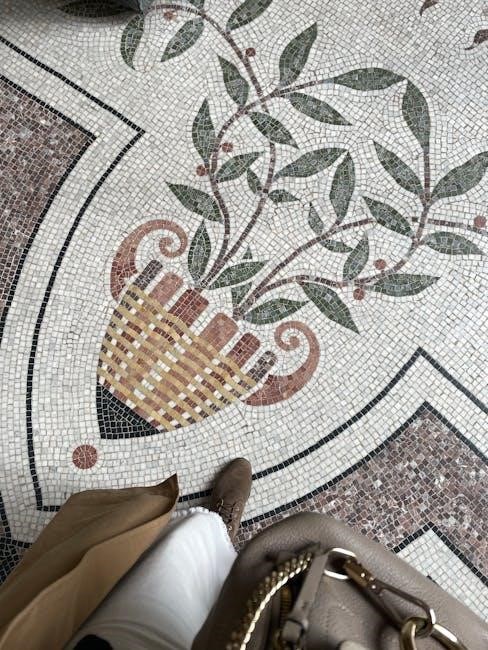The angle addition postulate is a fundamental concept in geometry, enabling the measurement of adjacent angles by summing their individual degrees.
It states that if point R lies within angle PQS, then the measure of angle PQR plus angle RQS equals angle PQS.
Students can master this concept using worksheet PDFs, offering structured problems and visual representations for clearer understanding and practical application.
1.1 Definition and Basic Concept
The angle addition postulate is a geometric principle that allows the measurement of adjacent angles by summing their individual measures.
It states that if a point lies within an angle, the sum of the measures of the two smaller angles formed equals the measure of the larger angle.
This postulate is essential for solving problems involving adjacent angles and is often applied in triangle and polygon angle calculations.
Worksheets incorporating this concept provide visual representations, helping students grasp and apply the postulate effectively in various geometric scenarios.
1.2 Importance in Geometry
The angle addition postulate is a cornerstone in geometry, enabling the measurement and analysis of adjacent angles within a single figure or shape.
It is crucial for solving problems involving triangle angle sums, polygon interior angles, and proving geometric theorems.
This postulate simplifies complex angle relationships, making it easier to calculate unknown angles in various geometric configurations.
By mastering this concept, students can better understand related principles, such as the exterior angle theorem and supplementary angles.
Practicing with worksheets reinforces this foundational skill, preparing learners for advanced geometric applications.

Benefits of Using Worksheets for Learning
Worksheets provide structured practice, enhancing problem-solving skills and understanding of geometric concepts like the angle addition postulate through visual and practical applications.
2.1 Visual Representation of Problems
Visual representation in worksheets enhances understanding by providing clear diagrams and labeled angles, making abstract concepts like the angle addition postulate more tangible for students. This approach allows learners to see how angles relate and interact, simplifying complex relationships. By breaking down problems into visual components, students can better grasp the postulate’s application, leading to improved retention and engagement. This method is particularly effective for visual learners, as it transforms theoretical ideas into practical, observable scenarios, fostering a deeper connection with geometric principles.
2.2 Enhanced Understanding for Students
Worksheets designed around the angle addition postulate offer students a structured platform to explore and apply geometric principles. By engaging with guided exercises, learners develop a stronger grasp of how angles combine and relate in various configurations. These resources often include step-by-step problems that build upon foundational concepts, helping students connect theory with practical application. Interactive elements further enhance comprehension, allowing learners to visualize and experiment with angle measurements. This hands-on approach fosters confidence in problem-solving and reinforces the postulate’s role in broader geometric contexts, making complex ideas more accessible and manageable for students at all skill levels.
2.4 Improved Problem-Solving Skills

Engaging with angle addition postulate worksheets enhances students’ problem-solving abilities by encouraging critical thinking and methodical reasoning. These resources provide a variety of exercises that require the application of the postulate to real-world scenarios, fostering analytical skills. Regular practice helps students break down complex problems into manageable steps, promoting a deeper understanding of geometric relationships. Over time, learners develop the ability to approach challenges systematically, improving their efficiency and accuracy. This structured practice not only strengthens mathematical reasoning but also builds confidence in tackling more advanced geometry topics.

How to Create Effective Worksheets
Effective worksheets for the angle addition postulate should start with clear instructions and definitions. Begin with basic problems to build foundational understanding, then gradually introduce more complex scenarios that require application of the postulate. Incorporate diagrams and visual aids to help students visualize adjacent angles and their relationships. Include a mix of numerical problems and word problems to provide varied practice. Offer opportunities for students to apply the postulate in real-world contexts, such as in architecture or art, to highlight its relevance. Finally, ensure the worksheet is organized logically, with space for students to show their work and explain their reasoning. This structured approach helps reinforce the concept and enhances problem-solving skills.
3.1 Identifying Key Concepts
When creating worksheets for the angle addition postulate, it’s essential to identify key concepts that students must grasp. These include understanding adjacent angles, the definition of the postulate, and its application in solving problems. Emphasize how the postulate relates to angle measurement and geometry. Highlight the importance of recognizing complementary and supplementary angles, as well as applying the postulate to triangles and polygons. Including these fundamental ideas ensures the worksheet focuses on essential skills and builds a strong foundation for further learning. This clarity helps students understand the postulate’s role in geometry and its practical uses.
3.2 Designing Clear and Concise Problems
Designing clear and concise problems is crucial for effective learning. Start with straightforward questions that focus on the angle addition postulate, such as calculating missing angles in simple diagrams. Use visual aids like diagrams and labels to enhance understanding. Avoid overly complex language or unnecessary distractions. Gradually introduce multi-step problems to build problem-solving skills. Ensure each problem has a clear solution path, and consider including hints or partial solutions for struggling students. This approach ensures that learners can focus on applying the postulate without confusion, making the worksheet both educational and engaging.
3.3 Incorporating Real-World Applications
Incorporating real-world applications into worksheets helps students see the practical value of the angle addition postulate. Examples include calculating angles in construction, such as ensuring beams fit together properly, or in sports, like determining the best angle for a golf swing. Artists can use the postulate to create balanced compositions, while engineers apply it in bridge design. By linking the postulate to real-life scenarios, worksheets become more engaging and relevant. This approach encourages students to think critically about how geometry solves everyday problems, making learning more meaningful and fun. Real-world connections enhance retention and motivation.

Popular Types of Angle Addition Postulate Worksheets
Worksheets often include basic problems, multi-step geometry challenges, and interactive digital exercises, catering to various skill levels and learning styles for comprehensive understanding.
4.1 Basic Angle Addition Problems
Basic angle addition problems focus on adjacent angles and supplementary angles, teaching students to measure angles in degrees and apply the postulate correctly. These problems often involve calculating missing angles or verifying if angles sum up to 180 degrees. Visual diagrams and straightforward calculations help students grasp the fundamental concept. Examples include finding unknown angles in simple diagrams or proving angle relationships. These problems are essential for building a solid foundation and are commonly found in angle addition postulate worksheet PDFs for beginner-level practice.
4.2 Multi-Step Geometry Problems
Multi-step geometry problems challenge students to apply the angle addition postulate in complex scenarios, often involving multiple angles or shapes. These problems require students to break down tasks into smaller steps, ensuring a deep understanding of angle relationships. Examples include calculating angles in triangles, polygons, or intersecting lines, where the postulate is applied sequentially. Such problems enhance critical thinking and problem-solving skills, preparing students for advanced geometry. Worksheets incorporating these exercises are widely available in angle addition postulate worksheet PDFs, offering varied challenges for different skill levels.
4.3 Interactive and Digital Worksheets
Interactive and digital worksheets are revolutionizing how students learn the angle addition postulate. These tools often feature draggable angles, real-time calculations, and interactive diagrams, making abstract concepts more tangible. Platforms like GeoGebra and Khan Academy offer dynamic exercises where students can visualize and experiment with angles. Digital worksheets also provide immediate feedback, helping students identify and correct mistakes. Many resources are available as angle addition postulate worksheet PDFs with embedded interactive elements. These innovative approaches cater to diverse learning styles, fostering engagement and deeper understanding of geometric principles. They are particularly effective for visual and kinesthetic learners, enhancing problem-solving skills and retention.

Solving Problems Using the Angle Addition Postulate
The angle addition postulate simplifies geometry by combining adjacent angles to find their sum, aiding in measuring angles and solving triangle-related problems effectively.
5.1 Step-by-Step Approach
Start by identifying the angles involved and ensuring they are adjacent, sharing a common side and vertex. Next, use the postulate to add their measures, calculating the total sum. For triangle problems, apply the postulate to find missing angles by subtracting the sum of known angles from 180 degrees. Use diagrams or visual aids to clarify spatial relationships and ensure accuracy. This methodical process enhances problem-solving skills and builds a strong foundation in geometry concepts. Regular practice with worksheets reinforces understanding and confidence in applying the postulate effectively.
5.2 Common Mistakes to Avoid
One common mistake is assuming all adjacent angles sum to 180 degrees, which only applies to supplementary angles forming a straight line. Another error is misapplying the postulate to non-adjacent angles or those without a shared vertex. Students often forget to verify if angles are supplementary before adding their measures. Additionally, there’s a tendency to overlook the importance of accurate angle measurement, leading to incorrect sums. Carefully checking angle relationships and measurements helps prevent these errors and ensures accurate problem-solving.
5.3 Real-World Applications
The angle addition postulate is essential in various real-world scenarios, such as construction, engineering, and art; For instance, architects use it to design precise angles for building structures, ensuring stability and symmetry. Engineers apply it in calculating stress loads on beams and bridges, where accurate angle measurements are critical. Artists utilize the postulate to create balanced compositions, ensuring visual harmony. These applications highlight the practical importance of mastering the angle addition postulate, making it a fundamental skill in both academic and professional settings. Understanding this concept enables individuals to solve real-world problems with precision and accuracy.

Key Concepts to Include in Worksheets
Worksheets should include definitions, properties, and theorems related to angles, along with practical exercises to reinforce understanding and application of the angle addition postulate;
6.1 Understanding Adjacent Angles
Adjacent angles are angles that share a common vertex and side. They are crucial for applying the angle addition postulate, as they often form the basis of problems. Understanding adjacent angles helps in identifying supplementary (sum to 180°) or complementary (sum to 90°) relationships. Students should learn to recognize and measure adjacent angles accurately. This concept is foundational for solving complex geometry problems, such as determining the measure of an exterior angle in a triangle. Including exercises that involve identifying and calculating adjacent angles will strengthen mastery of the angle addition postulate.
- Define adjacent angles and their properties.
- Provide examples of supplementary and complementary adjacent angles.
- Incorporate exercises to identify and measure adjacent angles.
6.2 Measuring Angles in Degrees
Measuring angles in degrees is essential for understanding geometric concepts. Using a protractor, students can accurately determine the size of an angle. This skill is foundational for applying the angle addition postulate. Angles are classified as acute (less than 90°), right (90°), obtuse (more than 90°), or straight (180°). Worksheets should include exercises that involve measuring and categorizing angles. This practice helps students visualize angles and their relationships, improving their ability to solve problems involving angle addition. Incorporating real-world examples, like measuring angles in triangles or shapes, enhances comprehension and practical application.
- Teach proper use of a protractor.
- Include exercises on classifying angles by degree measure.
- Provide real-world scenarios for practical application.
6.3 Using the Postulate in Triangle Problems
The angle addition postulate is crucial for solving triangle problems, where the sum of interior angles equals 180°. By breaking down complex angles into smaller, known angles, students can apply the postulate to find unknown measures. This is particularly useful in supplementary and complementary angle scenarios. Worksheets should include triangle diagrams with labeled angles, encouraging students to practice breaking down and adding angles. This skill is foundational for advanced geometry concepts, such as solving for missing angles in various triangle types, including right, isosceles, and scalene triangles.
- Provide triangle diagrams with labeled angles.
- Incorporate problems involving supplementary angles.
- Include examples of complementary angles in triangles.

Worksheet Examples and Solutions
Provides clear example problems and step-by-step solutions to help students master the angle addition postulate. Includes various problem types for comprehensive practice and understanding.
- Example 1: Calculate the missing angle in a triangle.
- Example 2: Solve for an unknown angle using supplementary angles.
- Example 3: Apply the postulate in a real-world scenario.
7.1 Sample Problems from the Internet
Online resources offer a variety of sample problems to practice the angle addition postulate. These include calculating missing angles in triangles, solving for supplementary angles, and applying the postulate to real-world shapes. Many worksheets feature visual diagrams, such as adjacent angles forming a straight line or angles around a point. Problems often range from basic calculations to more complex multi-step geometry questions. Websites like Khan Academy and Math Open Reference provide free PDFs with exercises that align with curriculum standards. These resources help students build confidence in using the postulate to find unknown angles in various geometric figures.
7.2 Detailed Solutions and Explanations
Detailed solutions and explanations are essential for mastering the angle addition postulate. They provide a clear, step-by-step breakdown of how to approach and solve problems. Many worksheets include visual aids, such as diagrams, to illustrate how angles combine. Explanations often highlight common mistakes and offer tips to avoid them. By understanding each step logically, students can grasp why the postulate works and how it applies to various geometric scenarios. These solutions reinforce learning and improve problem-solving skills, making them invaluable for both students and educators seeking to deepen mathematical understanding.
7.3 Answer Keys for Practice
Answer keys for practice are essential for verifying solutions to angle addition postulate problems. They provide clear, correct answers, enabling students to assess their understanding and accuracy. Detailed answer keys often include step-by-step solutions, helping learners identify mistakes and improve. For angle addition postulate worksheets, these keys highlight how angles sum up correctly, reinforcing the concept. Teachers and students alike benefit from these resources, as they ensure accuracy and build confidence in problem-solving skills. Accessible and organized, answer keys are invaluable for effective learning and assessment in geometry.

The Role of Technology in Learning
Technology enhances learning by providing interactive tools and resources, such as online worksheets and apps, to practice the angle addition postulate. These platforms offer real-time feedback, visualization, and accessibility, making geometry concepts more engaging for students. Interactive geometry software further supports understanding by allowing learners to explore and manipulate angles digitally. This integration of technology ensures a dynamic and effective learning experience tailored to modern educational needs.
8.1 Online Worksheets and Tools
Online worksheets and tools provide convenient and interactive ways to practice the angle addition postulate. Websites like Khan Academy and Mathway offer downloadable PDFs and interactive exercises. These resources often include visual aids, step-by-step solutions, and real-time feedback, enhancing understanding and retention. Tools like GeoGebra allow students to explore geometric concepts digitally, making abstract ideas more tangible. Additionally, online platforms cater to different learning styles, offering customizable difficulty levels and tracking progress. This accessibility ensures that students can practice anytime, anywhere, reinforcing their grasp of the angle addition postulate in a dynamic and engaging manner.
8.2 Interactive Geometry Software
Interactive geometry software, such as GeoGebra and SketchUp, revolutionizes learning by allowing students to explore geometric concepts dynamically. These tools enable users to construct and manipulate shapes, visualizing the angle addition postulate in real-time. Features like angle measurement tools and animation capabilities make abstract principles more concrete. Students can experiment with different scenarios, reinforcing their understanding through hands-on interaction. This software also supports collaborative learning and provides immediate feedback, making it an invaluable resource for both classrooms and individual study, complementing traditional worksheets and enhancing problem-solving skills in geometry.
8.3 Digital Resources for Teachers
Digital resources for teachers, such as lesson plans, interactive activities, and printable worksheets, are essential for effectively teaching the angle addition postulate. Websites like Teachers Pay Teachers and MathWorks offer a variety of materials tailored to different learning styles. Teachers can access pre-designed worksheet PDFs, video tutorials, and assessment tools. These resources save time and ensure comprehensive coverage of geometric concepts. Additionally, platforms like Google Classroom allow educators to share and assign digital worksheets easily, fostering a seamless learning experience for students while enhancing engagement and understanding of the angle addition postulate.

History and Development of the Postulate
The angle addition postulate traces its roots to ancient geometry, evolving through contributions of mathematicians like Euclid. It remains a foundational concept in understanding angle properties and relationships.
9.1 Origins in Geometry
The angle addition postulate has its roots in ancient geometry, particularly in the works of Euclid. In his seminal work Elements, Euclid formalized many geometric principles, including the concept of angle addition. This postulate, which states that the measure of an angle formed by two adjacent angles is the sum of their measures, was crucial for understanding other geometric concepts like supplementary angles and triangle properties. Its origins can be traced back to practical applications in construction and surveying by early civilizations, such as the Egyptians and Babylonians, who recognized the importance of angle relationships in their architectural and artistic endeavors. Over time, mathematicians refined these observations into formal principles, laying the foundation for the systematic study of geometry. This historical development underscores the postulate’s significance as a cornerstone of geometric thought, influencing both theoretical advancements and practical applications across cultures and centuries.
9.2 Historical Contributions to the Postulate
The angle addition postulate has been shaped by contributions from mathematicians across history. Euclid’s Elements laid the groundwork, while later scholars refined its applications in geometry. Pythagoras and his followers explored angle relationships in triangles, influencing the postulate’s use in calculating angles. Babylonian and Egyptian mathematicians also contributed by documenting angle measurements in their architectural feats. These historical contributions collectively established the postulate as a foundational concept in geometry, enabling further advancements in fields like trigonometry and spatial reasoning. Their work remains essential for understanding and applying the angle addition postulate in modern education and problem-solving.
9.3 Modern Applications in Math
The angle addition postulate remains vital in modern mathematics, particularly in fields like computer graphics, engineering, and architecture. It is essential for calculating angles in 3D modeling and ensuring precision in structural designs; Additionally, the postulate is used in artificial intelligence for spatial reasoning and in robotics for navigation systems. Its principles are also applied in GPS technology to determine precise locations through triangulation. These modern applications highlight the postulate’s enduring relevance, making it a cornerstone of both theoretical and practical mathematics. Its inclusion in educational resources, like worksheets, ensures future generations master these fundamental concepts.
The angle addition postulate is a foundational concept, bridging geometry’s past and future. Modern learning tools, like interactive worksheets, will enhance its understanding and application in coming years.
10.1 Summary of Key Points
The angle addition postulate is a fundamental concept in geometry, enabling the measurement and calculation of adjacent angles. Worksheets play a crucial role in helping students grasp this postulate by providing structured practice. They offer visual representations, enhance problem-solving skills, and bridge theoretical knowledge with real-world applications. Regular practice using these resources fosters a deeper understanding of angle relationships, especially in triangles and multi-step problems. By leveraging such tools, students can master the postulate, paving the way for advanced geometric concepts. Consistent practice and interactive learning methods ensure long-term retention and proficiency in geometry.
10.2 Encouraging Further Practice
Encouraging further practice with angle addition postulate worksheets is essential for mastery. Regular exercises help reinforce concepts and improve accuracy. Parents and educators can provide additional resources, such as PDF worksheets, to supplement classroom learning. Mixing basic problems with multi-step challenges keeps practice engaging. Incorporating real-world scenarios, like measuring angles in construction or art, makes learning relatable. Offering digital tools, such as interactive worksheets, can cater to different learning styles. Consistent practice builds confidence and prepares students for advanced geometry topics. Encouraging self-assessment and peer discussion further enhances understanding and retention.
10;3 The Future of Geometry Learning
The future of geometry learning lies in blending traditional methods with modern technology. Interactive tools and digital platforms are revolutionizing how concepts like the angle addition postulate are taught. Personalized learning experiences, adaptive software, and immersive technologies like AR/VR will make geometry more engaging. Worksheets, including PDF formats, will evolve to incorporate dynamic visuals and real-time feedback. Emphasizing real-world applications will help students see geometry’s relevance. Collaborative digital spaces will foster teamwork and problem-solving. These advancements promise to make geometry accessible, interactive, and exciting for future learners, ensuring the angle addition postulate remains a foundational skill.
